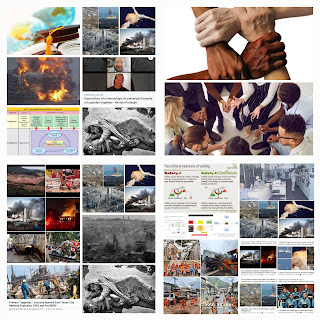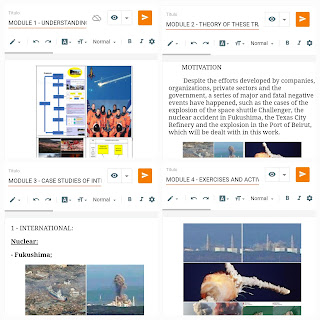Prevent Tragedies - Lessons learned from the Chernobyl accident and RISK MANAGEMENT modules, AND THE PROACTIVE SAFETY METHOD, RISKS AND EMERGENCIES
Figure 1 - Chernobyl accident
Lessons learned from the Chernobyl accident and ProSREM
Reference: Human and organizational factors in European nuclear safety: A fifty-year perspective on insights, implementations, and ways forward
On 26 April 1986, the Chernobyl accident
occurred near the city of Pripyat in Ukraine. The first information in the West was received
at the Forsmark NPP in Sweden, where radiation scanners reacted on people going
home after work. That caused some initial confusion, but investigations showed
that the contamination was coming from outside. Assessing the fallout, it
rapidly became clear that the likely origin was a nuclear accident abroad. The
Soviet authorities tried to cover up the accident to their own citizens for
about 36 h and, also, in their responses to the West.
When a satellite picture taken on 29 April
showed the burning reactor, they yielded and admitted that an accident had
taken place.
The sequence of events started with the
preparation to make a turbine roll-out test at around noon on 25 April, which
would end in a shutdown state of the reactor. Unfortunately, another regional
power unit went offline, and the grid control center asked the fourth Chernobyl
unit to extend its production. The plant agreed but left the emergency core
cooling system disabled, which was one of the preconditions for executing the
test. Around midnight, the grid control center stated that the shutdown could
resume, and the control room operators started preparations for carrying out
the test. Due to an apparent lack of understanding of the reactor’s dynamic behavior,
it was brought to an unstable state. The control room operators were presented
with indications they did not understand and when they activated the reactor
trip, that action determined the fate of the reactor. The reactor went prompt
critical and exploded in a power peak a thousandfold larger than the design
power of the reactor. This blast in turn caused a steam explosion, the second
explosion, which finally destroyed the reactor and its building.
The accident spread large amounts of radioactivity both locally and globally. It left an exclusion zone of about 2600 square kilometers uninhabitable for people. An understanding of the sequence of events together with the suffering of local people can be imagined when you read novels about the accident [21,22], which are based on the opening of old Soviet archives. The design of the reactor was developed from military reactors for plutonium production. The reactor was unstable (positive void coefficient) in low-power regions. The NPP site had no emergency plans and everything was handled in a culture of secrecy.
Officials were apparently afraid to make
decisions that could jeopardize their positions, which meant that almost
everything had to be checked with party officials in Moscow.
After the accident, an international meeting was assembled in Vienna on 25–29 August 1986 [23] and the term a deficient “nuclear safety culture” was used as an umbrella cause for many of the issues that are mentioned as more specific contributory causes (e.g., inappropriate design, no preparedness for emergencies, operators’ weak understanding of reactor dynamics). The report caused a lot of additional activity at the International Atomic Energy Agency (IAEA). The second document with HOF content was published in 1988 [24] and the third in 1991 [25], the latter defining how the concept of “safety culture” should be interpreted. Interestingly, this first conceptualization of safety culture also integrates so-called higher levels affecting nuclear plant safety.
Besides defining requirements in terms of managers’ and individuals’ commitment, the “highest” level is also addressed: the policy or “the legislative level, at which the national basis for Safety Culture is set” (25:5). Since then, several more of the so-called INSAG reports have been published as well as other reports providing guidance for how to assess and develop a safety culture in NPPs [26–29].
It took some time for the introduction of a
safety culture to settle in the nuclear industry. Without any scientific
foundation, this concept was out in the nuclear world; and it was necessary to
give life to an ambiguously defined concept, even if one was not even clear
about whether culture is meant as “a pattern for behavior” or “a pattern of behavior”
[30]. Accordingly, the way the concept of safety culture has been considered
within the industry depended very much on how corresponding national regulators
defined their own requirements regarding safety culture. This, in turn,
depended on how they reacted to the guidance obtained from IAEA, through direct
consulting and the so-called IRRT assessments [31], which is an activity with
peer reviews that national regulators are exposed to. A sweeping response was
that everything that had some relationship with safety and human behavior was
now seen as a component of the safety culture at a plant.
It is not possible to give a comprehensive
account of the HOF improvements that were made at the NPPs in the Western
world, but apparently—due to the large differences between the Chernobyl plants
and Western NPPs—they were mostly handled in training and written material,
which aimed at promoting a broader understanding of safety culture and its
practical implications for NPP operations. Nevertheless, we want to collect a
few events that can be considered as directly caused by the Chernobyl accident,
namely:
- This accident had a global impact on
radioactive fallout, which resulted in the forming of the World Association of
Nuclear Operators (WANO). The political state of the world at that time forced
the establishment of four regional offices (Atlanta, Moscow, Paris, and Tokyo)
with headquarters in London.
- European concerns for nuclear safety were
discussed at an EU level in Brussels, leading to the establishment of the Western
European Nuclear Regulators Association (WENRA), which—among other
activities—started work on increased harmonization of regulatory requirements
in Europe.
- Many plans for new reactors in Europe
were shelved.
In addition to these political developments, there have been increased efforts at institutional and academic levels to make the concept of a safety culture workable. These initiatives relate primarily to questions of what a safety culture is, and how it can be assessed and positively influenced, focusing on safety culture as a somewhat all-inclusive remedy [32,33]. In addition to these efforts, the concepts of organizational learning, as well as the management of safety, came increasingly into focus: on the one hand, as an important component of safety culture (in the case of organizational learning) [34], and on the other hand, as a means to foster or complement safety culture (in the case of safety management) [35,36], with which a more visible promotion and guidance of developing safety culture were promised. This focus was also triggered by an increasing change in political, regulatory, and economic parameters at the turn of the millennium, leading to the initiation of the EU LearnSafe project.




Comentários
Postar um comentário